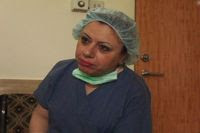Here is an example of that wonder of American generosity: “bringing democracy to the Middle East.” If only George could’ve left well enough alone. And his successor is proving to be equally incompetent.
Richard Jehn / The Rag Blog
Iraqi Doctors in Hiding Treat as They Can
By Dahr Jamail / February 21, 2009
BAGHDAD – Seventy percent of Iraq’s doctors are reported to have fled the war-torn country in the face of death threats and kidnappings. Those who remain live in fear, often in conditions close to house arrest.
“I was threatened I would be killed because I was working for the Iraqi government at the Medical City,” Dr. Thana Hekmaytar told IPS. Baghdad Medical City is the largest medical complex in the country.
Dr. Hekmaytar, a head and neck surgeon, has now been practising at the Saint Raphael Hospital in Baghdad for the last five years.
It is difficult now both as woman and as doctor, she says. Most women are now living in repressive conditions because the government is less secular. And that is besides the chaotic conditions around Iraq.
“It is particularly difficult for female doctors,” Dr. Hekmaytar says. “Large groups in Iraq only want us to stay at home, and certainly not be professionals.”
“We’ve had doctors kidnapped, and so many others have fled,” said Khaleb, a senior manager at the hospital who requested that his last name not be used. He named several doctors who had been kidnapped. This IPS correspondent, he said, was the first media person allowed into the hospital since the U.S. invasion of March 2003.
Doctors and other professionals become targets for kidnapping since they earn more money than most, and so fetch higher ransom.
“I’ve had to ask for security to protect the hospital,” Khaleb said. “After this, I went to Amman and convinced many of our doctors there to return. They did, but now they live in the hospital and never go outside. This has been the case since 2005. Every two months they leave to go visit their families in Jordan.”
Saint Raphael is a 35-bed hospital, but sees more than a thousand patients daily, says Khaleb. “Of our specialist doctors, ten live here full time. In addition, we have three younger doctors living here full time.”
Large concrete blocks restrict entry to the street leading up to the hospital. Iraqi army personnel guard the front door. Everyone entering the hospital is searched.
The hospital is located in the Karrada area of Baghdad, just across the Tigris river from the Green Zone. The neighbourhood is relatively safe by Baghdad standards, although attacks and car bombings still take place.
The hospital is on a side street close to several apartment buildings and private homes. Unlike most government hospitals it is clean and well stocked.
Dr. Hekmaytar is one of the doctors Khaleb persuaded to return to Baghdad. “Of course nobody likes to leave her home country, I was so sad,” she said. “I am grateful to be back, but wish it wasn’t under these difficult circumstances.”
Sitting with several doctors outside an operating room, she told IPS that death threats have never gone away.
“This is common here even now, but was especially so during 2004,” she said, as other doctors nodded in agreement. “Now I live and work in the hospital, and never leave.”
Dr. Hekmaytar, a Christian, received death threats twice. One came by way of a note in an envelope telling her to convert to Islam, or else. The second time she received a note in an envelope instructing her to where hijab. The note was enclosed with a bullet.
Dr. Shakir Mahmood Al-Robaie, an anaesthetist, too lives on the premises of the hospital where he works. “I both live and work here because I was threatened,” he told IPS. “My family is in Jordan.”
The doctor said his family received an envelope containing just a single bullet. After this, he moved his family to Jordan, and then returned to Iraq to get an income for himself and his family.
“Common? These threats are not just common,” said Dr. Jafir Hasily, a surgeon sitting across from Dr. Hekhaytar. “They are routine. This happens all the time.”
The Iraqi government estimates there were 36,000 doctors and medical personnel in Iraq when the U.S. invasion was launched in March 2003. Most escaped to neighbouring Arab countries, especially Jordan and Syria.
In early 2008, the Iraqi Health Ministry said that 628 medical personnel have been killed since 2003. Many believe the real figure is far higher, and that there is additionally a very large number of doctors who have been kidnapped and tortured.
In the absence of the doctors who left, particularly of senior doctors, the medical system is on the brink of collapse. It is short not just of doctors but also of other qualified staff, equipment and drugs. Patients are often forced to buy their own medicines on the black market.
Source / IPS News



















Perhaps someone can enlighten me.
Time and again it appears Western powers condemn fundamentalism , then attack middle eastern state that strive for secular ideals. It seems even Iran was headed for secularism, and making great strides forward, when interference from the West caused a change in direction. Why?
pms
pms — that is a very good question, and I don’t have a very good answer — but would just point out that religious fundamentalism knows no politicdal or national boundaries; that’s part of their “fundamentals”: religious loyalty trumps political loyalty. I mean, look at the US! We seemed to be heading in some generally positive directions socially, and towards a stronger secular model, when the “Moral Majority” was hatched to impel Reagan into office! What caused THAT change in direction?? I am almost willing to believe it was a fundamentalist muslim plot all along!!!